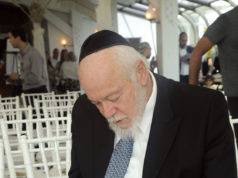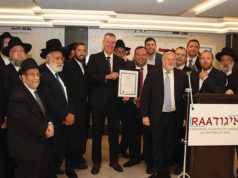
Romania is situated in the southeastern part of Central Europe and shares borders with Hungary to the northwest, Serbia to the southwest, Bulgaria to the south, the Black Sea and Ukraine to the southeast and to the north, and the Republic of Moldova to the east. Roughly the size of Oregon, Romania is the second largest country in the area, after Poland.
About a third of the country consists of the Carpathian Mountains (also known as the Transylvanian Alps). Another third is hills and plateaus, rich with orchards and vineyards. The final third is a fertile plain, largely devoted to agriculture. The Danube River runs through the country, from northwest to southeast, culminating in the Danube Delta and the Black Sea.
The dwindling Jewish community in Romania numbers about 14,000 out of a total population of 23.5 million. This population is mostly Ashkenazi, but at one time many Sephardim lived within Romania’s borders.
From the Middle Ages to modern times the Romanians lived in three distinct but neighboring principalities: Wallachia, Moldavia and Transylvania. During the second half of the 14th century a threat against the independent Romanian lands emerged: the Ottoman Empire. After first setting foot on European soil in 1354, the Ottoman Turks began their rapid expansion on the continent.
The whole Balkan Peninsula became a Turkish-ruled territory; Constantinople was captured by Mohammed II (1453), Suleiman the Magnificent captured the city of Belgrade (1521), and the Hungarian kingdom disappeared following the battle of Mohacs (1526). Therefore, Wallachia and Moldavia were surrounded and for over three centuries, they had to recognize the authority of the Ottoman Empire.
The end of the 17th century and the beginning of the 18th century brought about changes in the politics of Central and Eastern Europe. The Ottoman Empire failed to capture Vienna in 1683 and following that, the Hapsburg Empire began its expansion to the southeast of Europe. Many wars were fought by Austria and Russia against the Ottoman Empire. Many battles took place on Romanian soil, always accompanied by a foreign military occupation, which was often maintained long after the war was over. Thus the Romanian lands endured not only through devastation and irrecoverable losses, but also through population displacements and painful territory losses.
In 1718 Betalel Cohen, the son of Rabbi Naftali Cohen, Sultan Mustafa III’s protege, was appointed Hahambasi by Romanian Prince Alexandre Ipsilanti. The Hahambasi was in charge of all the Jews in the entire country. This office lasted until 1834 when it was dissolved. Instead of the Prince appointing the Hahambasi, it became the obligation of the Jewish people to elect their own spiritual leader.
The first Jews that arrived in Transylvania were from Turkey and the Balkans, due to the fact that Transylvania was on a trade route between the Orient and Europe. The first Jewish community was in Alba Julia, which has records of Jewish residency as early as 1591.
Jews continued to migrate to Transylvania in small numbers throughout the 17th to 19th centuries, even though there were residency restrictions until 1848. Most of the original Jewish population of Romania (from Turkey and the Balkans) were Sephardim. By the 19th century, the majority of the Jewish population were Ashkenazim, the result of waves of immigrants from Russia.
The number of Jews in Transylvania jumped from 2,000 in 1766, to 30,000 in 1880. In 1762, both Sephardic and Ashkenazi synagogues were built in Transylvania. Many Sephardic Jews also lived in various towns such as Dej, Carei and Cluj, and for many years small Sephardic communities of Ladino speakers also resided in the port towns of the Danube and in Southern Dobrudja.
In the 1800s, the northern province of Moldavia became the center of Jewish life. In 1803 there were only 15,000 Jews in Moldavia. By 1859 there were 118,000; and in 1899 there were 197,000. Fewer Jews lived in Wallachia: 4,000 in 1831; in 1859 the figure was 9,000; and in 1899, the total reached 61,000.
Romania proclaimed its independence from the Ottoman Empire on May 9, 1877, and participated alongside Russia in the war against the Turks. In 1881 Romania became a kingdom. With the achievement of national independence, Romanians in neighboring territories still under foreign domination began to look to Bucharest for inspiration. During the first half of the 19th century, the union into one single independent state became the ideal of many Romanians. The modern Romanian nation was founded in the winter of 1862.

Many Jews of Romania absorbed the naming practices of their community, taking the typical Romanian suffixes of -escu, -eanu and -aru, and Romanianized their original traditional surnames. Avram became Avramescu. Isaac became Isacescu; Ciubotaru (bootmaker), Fainaro (miller) and Sticlaru (glazier) were also popular Jewish names. The various Sephardic-specific surnames of Romania demonstrated the multi-ethnic roots of the Sephardim. This included the names: Alfanderi, Behar, Medina, Mitani, Nahmias, Papo, and Semo, representing Spain, Italy, Greece, Turkey and the Arabic countries.
During the summer of 1940 anti-Semitism flared, and in 1941 many pogroms occured. Jewish homes were looted, shops were burned, and many synagogues were desecrated, including two that were razed to the ground (the Great Sephardi Synagogue, Kahal Grande and the old Bet Ha-Midrash). Some of the leaders of the Bucharest community were imprisoned in the community council building, and worshipers were ejected from synagogues by force.
Over 264,000 Jews perished in Nazi death camps during World War II. Most of the survivors fled postwar communism and emigrated to Israel or the United States. Only 14,000 Jews, most aged over 60, live in Romania today.



